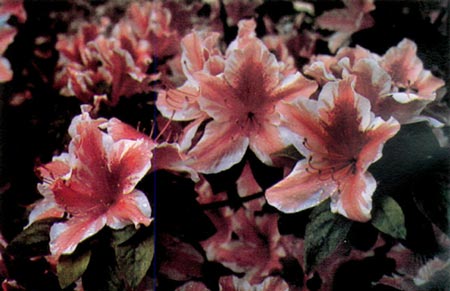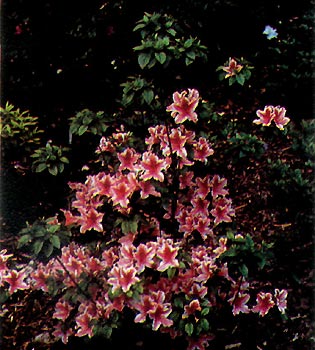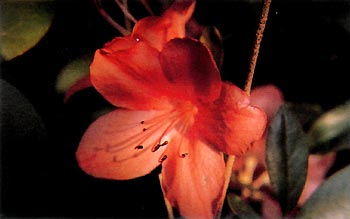JARS v38n4 - The Evergreen Azalea Cultivar Ben Morrison
The Evergreen Azalea Cultivar Ben Morrison
William C. Miller III, Bethesda, Maryland
Despite the fact that there are many questions surrounding the story of the origin of the azalea cultivar Ben Morrison, one fact remains on which most people can agree. Ben Morrison is a remarkably beautiful cultivar.

|
|
Ben Morrison in detail. While closely resembling
Glenn Dale hybrid 'Surprise', Ben Morrison is slightly larger and has more color in the stamens and pistil. Photo by William C. Miller III |
Selected by John L. Creech to honor Morrison in conjunction with the initiation of the B.Y. Morrison Lecture Series, Ben Morrison was introduced by Secretary of Agriculture Orville L. Freeman on June 26, 1968 at a meeting of the American Institute of Architects in Portland, Oregon. As the story goes, it is considered to be an unnamed Glenn Dale hybrid, presumably a sister seedling of 'Surprise', P.I. 163857, which it closely resembles. It was previously known as "B.Y.M. Special" and was remembered to be a particular favorite of Morrison's which made its selection particularly fitting. That is our understanding of the story.
The account is perfectly reasonable except for the difficulties encountered in tracing Ben Morrison back to a proper Bell number. The Bell number was the working number of the numbering system utilized at "Bell Station", as the Plant Introduction Station at Glenn Dale, Maryland was commonly called. It was a number assigned to crosses and additionally served as a means of individual plant identification prior to naming and the assignment of a plant introduction accession number ("P.I. Number"). All of Morrison's Glenn Dale hybrids, named or unnamed, should have at least one Bell number which relates back to its formula or cross. In the absence of a definitive Bell number for Ben Morrison, one cannot confirm a relationship with 'Surprise'. For example, it is known that 'Surprise' was B40241 and formerly B33364-91; that is, the 91st selection from lot or Cross B33364 which is described by ('Vittata Fortunei' x 'Louise') x 'Adzuma-no-hana'. Sister seedlings would share the same basic Bell number because they would be from the same Lot of seed. Therefore, without such a Bell number one has to consider the possibility that Ben Morrison arose from a different source than the cross that produced 'Surprise'; that they are not sister seedlings.
The story is further complicated by the fact that in Plant Inventories and correspondence from the Glenn Dale hybrid period, numerous references, in varying forms of punctuation and spelling, are made to a "B.Y.M. Special", the same initially associated with Ben Morrison. The problem is that they all seem to be references to the Glenn Dale 'Luna' P.I. 201896 which, according to its description in Monograph 20 1 , looks more like 'Alight' or 'Welcome' than 'Surprise'. The earliest reference to "B.Y.M.'s Special" that I have been able to locate in the files at the Plant Introduction Station is in a document entitled "GLENN DALE RHODODENDRON HYBRIDS LEFT FOR DISTRIBUTION." At the top it has a notation that a copy of the document was mailed to "B.Y.M." on October 30, 1951; otherwise it is undated. The document consists of two lists. The first list consists of named Glenn Dale hybrids with their associated Plant Introduction numbers. The second list consists of ten unnamed hybrids identified by their Bell number. It is in this second list that "B42495 Rhodo hybrid B.Y.M.'s Special" is found. Penciled in is the name 'Luna' and the P.I. number 201896 which is consistent with the reference to the Glenn Dale 'Luna' in Monograph 20.
In later documents, well after the Glenn Dale work was completed, Bell number B42495 becomes associated with Ben Morrison. The description for Ben Morrison and 'Luna' are not close enough to entertain the possibility of the plants being the same which is what sharing the same Bell number suggests. Luna', which I have not seen, is bordered and Ben Morrison is not. This confusing situation can be reduced to a relatively simple mathematical expression which states that:
A=B=C=D, where A represents Ben Morrison, B represents "B.Y.M. Special", C represents B42495, and D represents 'Luna'. The problem arises when we recognize that, contrary to the available evidence, an inequality exists between A and D; that is, A and D are clearly different.
Contrary to Evans 2 , I am not inclined to try to distinguish between the appellations "B.Y.M. Special" and "B.Y.M.'s Special". I believe that they are forms of the same name and reflect reasonable spelling and punctuation differences of different people over time. But, at the same time, it may have been a relatively common practice to mark plants as "special". For example, there is a single notation in a list of selections for 1947 that B39484 ('Carnival') was "Special" in some regard. Further, I would submit for your consideration that 'Luna' has just as valid a claim to the nickname "B.Y.M. Special" as it is quite special in its own right. One of the last of the 454 Glenn Dale hybrids to be introduced, it is the only representative from its cross that survived the evaluation and selection process to become a Glenn Dale hybrid. Identified as B42495 and introduced under P.I. 201896 it is described by the formula kaempferi x 'Shinnyo-no-tsuki'. According to distribution records, 'Luna' was only distributed in 1952, and only twenty recipients received distributions that year which accounts for its relative rarity. In my mind, it is unlikely that Ben Morrison is a sport of 'Luna' which would permit them to share B42495. It is my belief that the association of B42495 with Ben Morrison is an error, and that B42495 is, in fact, the Glenn Dale hybrid 'Luna'.

|
|
Ben Morrison in the author's garden.
Officially described in Plant Inventory No. 176, January 1 to December 31, 1968, United States Department of Agriculture Washington, D.C. (1969) as... to 3 feet high; dense, twiggy; leaves medium green, dull, semi-evergreen flowers single to 3 inches across in clusters, ground color Empire Rose with showy blotch of Tynan Rose, petal margins irregularly white. Mid to late May. Hardy at Glen Dale, Md. Photo by William C. Miller III |
One theory warranting further evaluation, which I have been unable to discount, and which has more than a reasonable basis for belief, is the possibility that Ben Morrison might be a derivative of the Belgian Glenn Dale effort 3 . The Belgian Glenn Dale work followed on the heels of the Glenn Dale hybrids (late 1940's) and conceivably could have resulted in the production of such a plant. The timing fits and one could argue that the Belgian Glenn Dales are Glenn Dale hybrids though I prefer to distinguish between the two groups. This theory would explain the difficulty in tracing Ben Morrison back to 'Surprise' (since they would be unrelated), while permitting Ben Morrison to be considered a "Glenn Dale hybrid", in the generic sense, because it was developed at the Plant introduction Station at Glenn Dale, Maryland.
If that is not enough, an additional area for real confusion is presented by the existence of the similarly named but unrelated cultivar, B. Y. Morrison 2 . Of unknown origin, it was privately distributed by Henry J. Hohman in the early 1960's. Blooming significantly later (early June in the Washington D.C. area) than Ben Morrison and described as an "orangish, dull red" (HCC 18, RHS 41A), it is beginning to appear in the trade.

|
|
B. Y. Morrison in detail.
Photo by William C. Miller III |
While we may never ascertain the complete picture, and care will be necessary to keep things straight, the inescapable fact remains that Ben Morrison is a superior evergreen cultivar which is every bit worthy of the attention that it has received in recent years.
References and Notes
1. Morrison, B.Y., The Glenn Dale Azaleas, Monograph No 20, U.S. Department of Agriculture. U.S. Government Printing Office (1953).
2. Evans, C.H., "Origins of the Evergreen Hybrids 'Ben Morrison' and 'B. Y. Morrison'", THE AZALEAN, Vol. 6, No 1, p 11-12 (1984).
3. Miller III, W.C. "The Belgian Glenn Dale Hybrids, THE AZALEAN Vol. 6, No 2, p 33-35 (1984).
